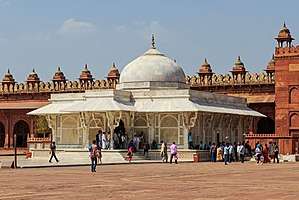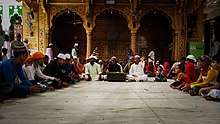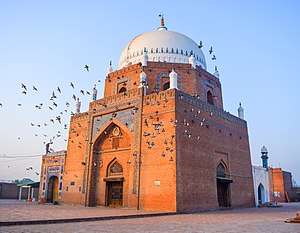Dargah
A dargah (Persian: درگاه dargâh or درگه dargah, Turkish dergâh, also in Urdu and Bengali: দরগাহ dorgah) is a shrine built over the grave of a revered religious figure, often a Sufi saint or dervish. Sufis often visit the shrine for ziyarat, a term associated with religious visits and “pilgrimages”. Dargahs are often associated with Sufi eating and meeting rooms and hostels, called khanqah or hospices. They usually include a mosque, meeting rooms, Islamic religious schools (madrassas), residences for a teacher or caretaker, hospitals, and other buildings for community purposes. The same structure, carrying the same social meanings and site of the same kinds of ritual practice, is called maqam in the Arabic-speaking world.
| Part of a series on Islam Sufism |
|---|
|
List of sufis |
|
|




Etymology
Dargah is derived from a Persian word which literally means "portal" or "threshold."[1]
Some Sufi and other Muslims believe that dargahs are portals by which they can invoke the deceased saint's intercession and blessing (as per tawassul, also known as dawat-e-qaboor[2] or Ilm e dawat). Still others hold a less important view of dargahs, and simply visit as a means of paying their respects to deceased pious individuals or to pray at the sites for perceived spiritual benefits.
However, dargah is originally a core concept in Islamic Sufism and holds great importance for the followers of Sufi saints. Many Muslims believe their wishes are fulfilled after they offer prayer or service at a dargah of the saint they follow. Devotees tie threads of mannat (hope) at dargahs and contribute for langar and pray at dargahs. Dargahs dotted the landscape of Punjab even before the partition of the Indian Subcontinent[3].
Over time, musical offerings of dervishes and sheikhs in the presence of the devout at these shrines, usually impromptu or on the occasion of Urs, gave rise to musical genres like Qawwali and Kafi, wherein Sufi poetry is accompanied by music and sung as an offering to a murshid, a type of Sufi spiritual instructor. Today they have become a popular form of music and entertainment throughout South Asia, with exponents like Nusrat Fateh Ali Khan and Abida Parveen taking their music to various parts of the world.[4][5]
Throughout the non-Arab Muslim world
Sufi shrines are found in many Muslim communities throughout the world and are called by many names. The term dargah is common in the Persian-influenced Islamic world, notably in Iran, Turkey and South Asia[6].
In South Africa, the term is used to describe shrines in the Durban area where there is a strong Indian presence, while the term keramat is more commonly used in Cape Town, where there is a strong Cape Malay culture[7].
In South Asia, dargahs are often the site of festivals (milad) held in honor of the deceased saint on his passing away anniversary (urs). The shrine is illuminated with candles or strings of electric lights at this time[8].
In China, the term gongbei is usually used for shrine complexes centered around a Sufi saint's tomb[9].
Worldwide
There are many active dargahs open to the public worldwide where aspirants may go for a retreat. The following is a list of dargahs open to the public.
- Baghdad Sharif Dargah of Abdul Qadir Jilani, Ajmer, Baghdad, Iraq
- Dargah Lal Shahbaz Qalandar, Sehwan Sharif, Sindh, Pakistan
- Dargah Murshid Nadir Ali Shah, Sehwan Sharif, Sindh, Pakistan
- A.K.Khan Dargah of Shaiykh Saiyed Razzaq Ali Gilani, Pahartali, Chittagong, Bangladesh
- Ajmer Sharif Dargah of Moinuddin Chishti, Ajmer, Rajasthan, India
- Hazrat Syed Ashraf Jahangir Semnani at Ashrafpur Kichhauchha, Uttar Pradesh, India
- Dargah of Shah Ata in Gangarampur, West Bengal, India[10]
- Erwadi, Tamil Nadu, India
- Nagore, Tamil Nadu, India
- Thiruparankundram Dargah, Tamil Nadu, India
- Humaithara, Egypt
- Madurai Hazrat Maqbara, Madurai, Tamil Nadu, India [11]
- Sheikh Nazim Al-Haqqani in Lefka, Cyprus[12]
Opposition by Radical Sunni groups
The Ahl-i Hadith, Deobandi, Salafi and Wahhabi religious scholars argue against the practice of constructing shrines over graves, and consider it as associating partners with God or shirk.[13] The Prophet Muhammad strongly condemned the practice of turning graves into places of worship and even cursed those who did so.[14][15] The current Wahhabi rulers of Saudi Arabia have destroyed more than 1400-year-old grave sites of companions and ahl al-bayt including Othman, Khadija and Aisha amongst numerous others,[16][17][18] although visiting graves is encouraged in Islam to remember death and the Day of Judgment.[18][19][20]
See also
| Wikimedia Commons has media related to Dargahs. |
References
- Delage, Remy; Boivin, Michel (2015). Devotional Islam in Contemporary South Asia: Shrines, Journeys and Wanderers. Routledge. ISBN 9781317380009.
- Bilgrami, Fatima Zehra (2005). History of the Qadiri Order in India. Idarah-i Adabiyat-i Delli. p. 291.
- Snehi, Yogesh (October 2013). "Replicating Memory, Creating Images: Pirs and Dargahs in Popular Art and Media of Contemporary East Punjab" (PDF). Retrieved 2020-06-07. Cite journal requires
|journal=(help) - Kafi South Asian folklore: an encyclopedia : Afghanistan, Bangladesh, India, Nepal, Pakistan, Sri Lanka, by Peter J. Claus, Sarah Diamond, Margaret Ann Mills. Taylor & Francis, 2003. ISBN 0-415-93919-4. p. 317.
- Kafi Crossing boundaries, by Geeti Sen. Orient Blackswan, 1998. ISBN 8125013415. p. 133.
- Alkazi, Feisal (2014). Srinagar: An Architectural Legacy. New Delhi: Roli Books. ISBN 978-93-5194-051-7.
- Acri, Andrea; Ghani, Kashshaf; Jha, Murari K.; Mukherjee, Sraman (30 December 2019). Imagining Asia(s): Networks, Actors, Sites. Singapore: ISEAS. ISBN 978-9814818858.
- Currim, Mumtaz; Michell, George (1 September 2004). Dargahs, Abodes of the Saints. Mumbai: Marg Publications. ISBN 978-8185026657.
- "Muslim Architecture". China.org. Retrieved 2020-06-07.
- "History of Dargah of Shah Ata". Asikolkata.in. ASI, Kolkata Circle. Retrieved 2017-08-22.
- "Madurai Maqbara".
- "Sheikh Nazım Al Haqqani Al Qubrusi An Naqshibandi". Retrieved 6 April 2016.
- "Building Mosques or Placing Lights on Graves" (PDF). 21 March 2008. Retrieved 11 July 2014.
- https://sunnah.com/muslim/5/21
- https://sunnah.com/bukhari/60/121
- Sunan an-Nasa'i 2047.
- Sunan an-Nasa'i 2046.
- Ondrej, Beranek; Tupek, Pavel (July 2009). Naghmeh, Sohrabi (ed.). From Visiting Graves to Their Destruction: The Question of Ziyara through the Eyes of Salafis (PDF). Crown Paper (Crown Center for Middle East Studies/Brandeis University). Brandeis University. Crown Center for Middle East Studies. p. 19. Archived (PDF) from the original on 10 August 2018.
Relying mainly on hadiths and the Qur’an, Ibn ‘Abd al-Wahhab’s most famous work, The Book of God’s Unicity (Kitab al-tawhid), describes a variety of shirk practices, such as occultism, the cult of the righteous (salih), intercession, oaths calling on other than God himself, sacrifices or invocational prayers to other than God, and asking other than Him for help. Important things about graves are remarked on in a chapter entitled “About the Condemnation of One Who Worships Allah at the Grave of a Righteous Man, and What if He Worships [the Dead] Himself.”72 Ibn ‘Abd al-Wahhab starts by quoting a hadith: “Umm Salama told the messenger of Allah about a church she had seen in Abyssinia in which there were pictures. The Prophet said: ‘Those people, when a righteous member of their community or a pious slave dies, they build a mosque over his grave and paint images thereon; they are for God wicked people.’ They combine two kinds of fitna: the fitna of graves and the fitna of images.” He then continues with another hadith: “When the messenger of Allah was close to death, he . . . said: ‘May Allah curse the Jews and Christians who make the graves of their prophets into places of worship; do not imitate them.’” From this hadith Ibn ‘Abd al-Wahhab derives the prohibition of building places of worship over graves, because that would mean glorification of their inhabitants, which would amount to an act of worship to other than Allah.
- "The Book of Prayer - Funerals - Sahih Muslim - Sunnah.com - Sayings and Teachings of Prophet Muhammad (صلى الله عليه و سلم)". Retrieved 6 April 2016.
- "Shrine - Oxford Islamic Studies Online". www.oxfordislamicstudies.com. Retrieved 2018-08-10.
Many modern Islamic reformers criticize visits to shrines as mere superstition and a deviation from true Islam.
